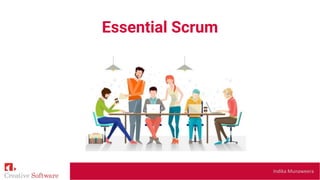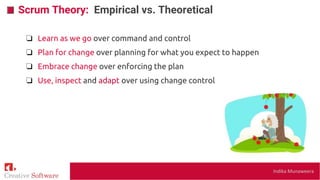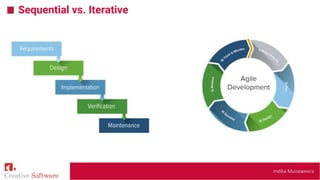Agile - Essential Scrum
- 2. Indika Munaweera â Introduction to Agile Software Development â Principles of Agile (Agile Manifesto) â Scrum Overview â Scrum Theory â Scrum Values â Parts of Scrum â The Scrum Team - Roles â Scrum Events â Scrum Artifacts â References
- 3. Introduction to Agile Software Development Indika Munaweera What is Agile? The ability to create and respond to change in order to succeed in an uncertain and turbulent environment. What is Agile Software Development? Agile Software Development is an umbrella term for a set of methods and practices based on the values and principles expressed in the Agile Manifesto. Solutions evolve through collaboration between self-organizing, cross- functional teams utilizing the appropriate practices for their context.
- 4. Indika Munaweera â Individuals and interactions over processes and tools â Working software over comprehensive documentation â Customer collaboration over contract negotiation â Responding to change over following a plan
- 5. Principles of Agile Indika Munaweera â Customer satisfaction by rapid, continuous delivery of useful software â Working software is delivered frequently (weeks rather than months) â Working software is the principal measure of progress â Even late changes in requirements are welcomed â Close, daily cooperation between business people and developers â Face-to-face conversation is the best form of communication (Co-location) â Projects are built around motivated individuals, who should be trusted â Continuous attention to technical excellence and good design â Self-organizing teams â Regular adaptation to changing circumstances
- 7. Indika Munaweera Scrum Overview Scrum (n): A framework within which people can address complex adaptive problems, while productively and creatively delivering products of the highest possible value. â Lightweight â Simple to understand â Difficult to master Scrum is not a process, technique, or definitive method. Itâs a framework.
- 8. Indika Munaweera Scrum Theory: Empirical vs. Theoretical â Learn as we go over command and control â Plan for change over planning for what you expect to happen â Embrace change over enforcing the plan â Use, inspect and adapt over using change control
- 9. Indika Munaweera Sequential vs. Iterative
- 11. Indika Munaweera Parts of Scrum: 3 - 3 - 5 Roles Events Artifacts
- 12. Indika Munaweera Scrum Roles Image Source: https://www.oreilly.com/library/view/the-professional-scrummasters/9781849688024/ch01s04.html
- 13. Indika Munaweera Scrum Roles- The Product Owner â Clearly express Product Backlog items â Ordering the items in the Product Backlog to best achieve goals and missions â Optimizing the value of the work the Development Team performs â Ensuring that the Product Backlog is visible, transparent, and clear to all, and shows what the Scrum Team will work on next â Ensuring the Development Team understands items in the Product Backlog to the level needed.
- 14. Indika Munaweera Scrum Roles- The Scrum Master â Ensuring that goals, scope, and product domain are understood by everyone on the Scrum Team as well as possible â Finding techniques for effective Product Backlog management â Helping the Scrum Team understand the need for clear and concise Product Backlog items â Understanding product planning in an empirical environment â Ensuring the Product Owner knows how to arrange the Product Backlog to maximize value â Understanding and practicing agility â Facilitating Scrum events as requested or needed
- 15. Indika Munaweera Scrum Roles- The Development Team â Ensuring that goals, scope, and product domain are understood by everyone on the Scrum Team â Finding techniques for effective Product Backlog management â Cross-functional teamwork and collaboration â Participates in Scrum Events â Understanding product planning in an empirical environment â Helping backlog refinement to ensure that the Product Owner knows how to arrange the Product Backlog to maximize value â Understanding and practicing agility â Facilitating Scrum events as requested or needed
- 16. Indika Munaweera Scrum Events Image Source: https://nomad8.com/how-to-run-a-sprint-planning-meeting-the-way-i-like-it/
- 17. Indika Munaweera The Sprint - The heart of Scrum â A Sprint is time-boxed of one month or less â Useable, and potentially releasable product Increment is created â No changes are made that would endanger the Sprint Goal â Quality goals do not decrease â Scope may be clarified and re-negotiated between the Product Owner and Development Team as more is learned
- 18. Indika Munaweera Sprint Planning â Sprint Planning is time-boxed to a maximum of eight hours for a one-month Sprint â Product Owner presents the ordered product backlog to the development team â The Development Team selects items for the next Sprint â During Sprint Planning the Scrum Team also crafts a Sprint Goal â The development team does planning and design to make sure that they will achieve the Sprint Goal â Output is Sprint goal, sprint backlog, a clear understanding of work to be done during the sprint and transparency
- 19. Indika Munaweera Daily Scrum â Daily Scrum is a daily 15-minute time-boxed standup meeting of the Scrum Team â Scrum master makes sure that the each member participates in the daily standup â Input - 3 questions - "What did I do yesterday?", "What will I do today?" "Are there any issues or Impediments?" â Output - Clear idea about the progress towards the Sprint goal and any issues or impediment idea in the earlier stage. Image Source: https://taylorsmith.org/sprint-retrospective-meeting- template
- 20. Indika Munaweera Scrum Review â Typically a four-hour meeting for one-month Sprints and held at the end of the Sprint â Attendees include the Scrum Team and key stakeholders invited by the Product Owner â The Product Owner explains what Product Backlog items have been "Done" and what has not been "Done" â The Development Team discusses how Sprint was done and demonstrates the work that it has "Done" â Input - Product Increment, Changes to the product backlog during the Sprint. â Output - Updated product backlog, New Idea, clear picture of tasks and product.
- 21. Indika Munaweera Scrum Retrospective â The Sprint Retrospective occurs after the Sprint Review and prior to the next Sprint Planning â This is at most a three-hour meeting for one-month Sprints. â Inspect how the sprint went with regard to process, tool, and people. â Identify items that went well and potential improvements. â Create an action plan to implement improvements in the scrum team. â Scrum Master encourages the team to improve. In the Scrum process framework, practices of processes make tasks more effective and enjoyable for the next Sprint. Image Source: https://taylorsmith.org/sprint-retrospective-meeting-template
- 22. Indika Munaweera Scrum Artifacts Image Source: https://projectresources.cdt.ca.gov/wp-content/uploads/sites/50/2017/08/sprint-artifacts.jpg
- 23. Indika Munaweera Product Backlog â It is an ordered list of everything that is known to be needed in the product â Generally, tasks which have more business values are the top priority â A Product Backlog is never complete and evolves as the product â Each product item has an Order, Value, Description, and Estimation â Product Owner owns the product backlog and he makes sure that the product backlog is clear and transparent to the team â Anyone from the team can add an idea in the product backlog but it's product owner who decides which one stays there â Product Backlog refinement is the act of adding detail, estimates, and order to items in the Product Backlog
- 24. Indika Munaweera Sprint Backlog â Set of product backlog items selected for the sprint â Sprint Backlog makes visible all of the work items that development team identifies as a priority to meet the sprint goal â Owned by development team and updated by only development team during the sprint â Sprint goal is fixed but new tasks which need to complete the sprint goal can be added to the sprint backlog during the sprint â It is critical that team will only commit to items that they can complete in particular sprint â Sprint Burndown and Sprint Burnup Chart will be managed during the sprint
- 25. Indika Munaweera Scrum Increment â It's a sum of all the tasks from product backlog that are completed during the sprint and all previously completed sprints. â All tasks must meet acceptance criteria and meet the definition of 'Done'. â Product Owner decides which tasks have been done and are ready for release.
- 26. Indika Munaweera Recap - Scrum Overview
- 27. Indika Munaweera References â Manifesto for Agile Software Development - http://agilemanifesto.org/ â Agile Alliance - https://www.agilealliance.org/agile101/ â The Scrum Guide - https://www.scrumguides.org/scrum-guide.html




























